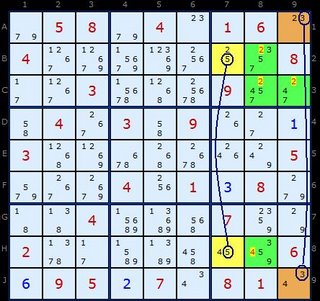I've named this strategy Multivalue because we're dealing with several candidate values but the formation is exactly as an X-Wing, infact it also follows the generalised x-wing as described above.

Take a look at this rectangular formation made from the yellow and brown cells. Connecting the two yellow cells is a conjugate pair of 6, the only two sixes in the row. In the other row connecting the two brown cells is a conjugate pair of 5. What connects the cells in the columns are the additional candidates, in this case 1 in column 1 and 9 in column 9. Note that there are additional 1's and 9's in these columns. These are the candidates we can eliminate and they are highighted in green cells.
The logic goes as follows: 6 must occur in one of the two yellow cells and the 5 must occur in one of the brown cells. No doubt about that. But both 6 and 5 cannot occur in the same column. Lets pretend they do, say 6 and 5 in column 1. That would leave 9 as the only solution in two cells in column 9. Can't have that. So which ever way round 6 is 5 will be in the opposite column. This forces the 1 and 9 to fill the remaining two corners. If 1 and 9 are guaranteed to be in either a yellow or a brown cell apiece then we can't have any more 1s and 9s in those columns. Hense the eliminations.
The logic goes as follows: 6 must occur in one of the two yellow cells and the 5 must occur in one of the brown cells. No doubt about that. But both 6 and 5 cannot occur in the same column. Lets pretend they do, say 6 and 5 in column 1. That would leave 9 as the only solution in two cells in column 9. Can't have that. So which ever way round 6 is 5 will be in the opposite column. This forces the 1 and 9 to fill the remaining two corners. If 1 and 9 are guaranteed to be in either a yellow or a brown cell apiece then we can't have any more 1s and 9s in those columns. Hence the eliminations.

The generalised X-Wing theory says that we can have a distorted X-Wing starting from 2 boxes and eliminating in 2 rows or 2 columns. This next example does just that. We have a strong link between the yellow cells (B7 and H7) using 5. And another string link between brown cells (A9 and J9). Since the top pair share a box and the bottom pair also share a box we don't need exact row alignment.
Using the arguement above we know that one 5 or 3 will occur in B7 or A9 focing the other cell in the top right box to be a 2. We don't know which yet, but of those two cells will be a 2 so all the others in the box can go.
Likewise, a 5 or a 3 will appear one of the cells int the bottom box, H7 or A9. That forces 4 to be the solution to that pair - we just don't know which way round yet. The 4 in H8 can go.
Eliminations such as these can be achieved using Nice Loops and other very advanced strategies but this is well worth looking out for separetely since its both easier to spot and extends the elegance of the familiar X-Wing.
No comments:
Post a Comment